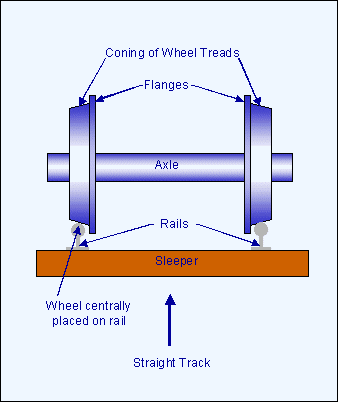Evolution of N Scale Flange Size
Published: 2016-10-27 - By: gdm
Last updated on: 2021-01-14
Last updated on: 2021-01-14
visibility: Public

Over time, N Scale flange sizes have evolved to better match prototypes and appear closer to scale. There are three basic kinds of flange varieties: High, Low and Standard Profile.
Early N Scale locomotives and rolling stock were all equipped with high profile / deep-flange wheels. These deep flanges were very good at keeping the cars on the tracks but due to the unrealistic appearance of the flanges, these wheels were known throughout the hobby as 'pizza cutters." These wheels, though a bit of an eyesore, worked just fine with early N Scale track and as long as the cars were on the track, the flanges were hidden by the rails.
This all changed with the introduction of Code-55 N Scale track in the 1990s. This new track was much thinner (vertically speaking) than its predecessor (now known as Code-80). The new track looked much more realistic to the eye, but unfortunately was incompatible with the deep flanges of older locos and rolling stock. The flanges were deeper than the track was high causing erratic running and poor behavior when passing through turnouts.
In response, the manufacturers began to reduce the size of the flanges so that their products would run well on either kind of track. These new wheels were known as "low profile / fine scale" Although these new wheels have the advantage of running on Code-55 and Code-80 track, the reduced flange size has a major disadvantage: they can derail far more easily than their pizza-cutting siblings. The deep flanges allow for more tolerance of poor track-work. As a result, NTRAK categorically rejected (until just recently) the use of Code-55 on their specification, which requires all modules to be tracked with Code-80 track. They did make an exception for hybrid track such as made by Peco, where the external appearance of the track was Code 55 but the internal height allowed for deep flange. NTRAK members frequently have fleets of older cars with deep-flange wheels and furthermore due to the heterogeneous nature of track work on an NTRAK layout, the deep flanges simply work better.
This in turn created a dilemma for the manufacturers. Should they go with deep flanges and make the NTRAK folks (a major customer base) happy or instead make the modelers happy with more realistic looking low-profile products?
Micro-Trains settled on a compromise between High Profile and Low Profile: the "Standard" wheel flange. Most other companies went with low profile wheels as even though they don't run as well on questionable track work, they *always* run.
Here are the facts:
Early N Scale locomotives and rolling stock were all equipped with high profile / deep-flange wheels. These deep flanges were very good at keeping the cars on the tracks but due to the unrealistic appearance of the flanges, these wheels were known throughout the hobby as 'pizza cutters." These wheels, though a bit of an eyesore, worked just fine with early N Scale track and as long as the cars were on the track, the flanges were hidden by the rails.
This all changed with the introduction of Code-55 N Scale track in the 1990s. This new track was much thinner (vertically speaking) than its predecessor (now known as Code-80). The new track looked much more realistic to the eye, but unfortunately was incompatible with the deep flanges of older locos and rolling stock. The flanges were deeper than the track was high causing erratic running and poor behavior when passing through turnouts.
In response, the manufacturers began to reduce the size of the flanges so that their products would run well on either kind of track. These new wheels were known as "low profile / fine scale" Although these new wheels have the advantage of running on Code-55 and Code-80 track, the reduced flange size has a major disadvantage: they can derail far more easily than their pizza-cutting siblings. The deep flanges allow for more tolerance of poor track-work. As a result, NTRAK categorically rejected (until just recently) the use of Code-55 on their specification, which requires all modules to be tracked with Code-80 track. They did make an exception for hybrid track such as made by Peco, where the external appearance of the track was Code 55 but the internal height allowed for deep flange. NTRAK members frequently have fleets of older cars with deep-flange wheels and furthermore due to the heterogeneous nature of track work on an NTRAK layout, the deep flanges simply work better.
This in turn created a dilemma for the manufacturers. Should they go with deep flanges and make the NTRAK folks (a major customer base) happy or instead make the modelers happy with more realistic looking low-profile products?
Micro-Trains settled on a compromise between High Profile and Low Profile: the "Standard" wheel flange. Most other companies went with low profile wheels as even though they don't run as well on questionable track work, they *always* run.
Here are the facts:
- Only Micro-Trains models produced on (or after) March 2010 have "standard" 33" diameter wheels. (33" diameter wheels are the most common wheel size, used on all cars up to 70-ton capacity.)
- Except for many late production brass N-Scale models, nickel silver or chemically blackened wheeled N-Scale models from the late 1960s through the 1990s have "deep flange" wheels.
- Delaware Valley, Precision Masters, MDC Roundhouse (kit cars), and some Atlas Model Railroad (i.e., never any Atlas Tool Co. products) and Intermountain Railway cars from the 1990s have "low profile" injection molded (typically in brown) wheels.
- Chinese manufactured MDC Roundhouse RTR cars have "low profile" chemically blackened wheels.
- Pre Y2K Model Power cars have "deep flange" wheels.
- The appearance of "low profile" wheeled Model Power cars seems to be circa mid-2000.

